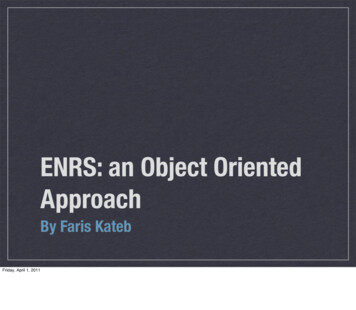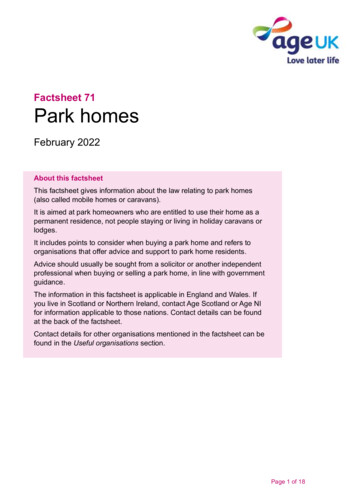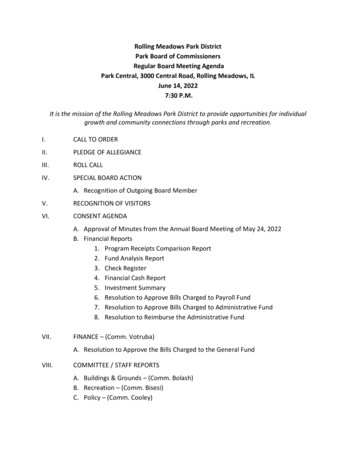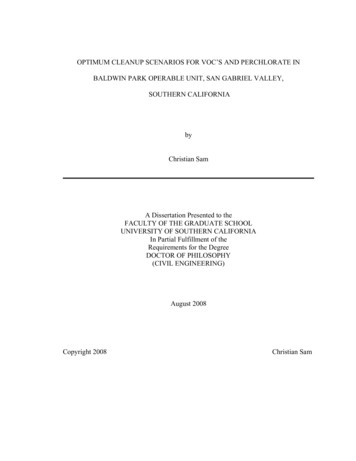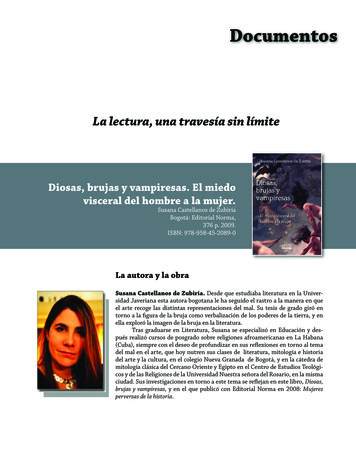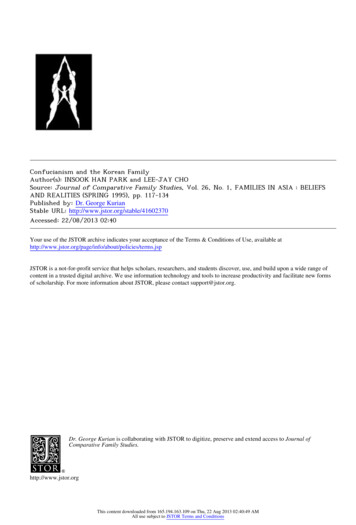
Transcription
Confucianism and the Korean FamilyAuthor(s): INSOOK HAN PARK and LEE-JAY CHOSource: Journal of Comparative Family Studies, Vol. 26, No. 1, FAMILIES IN ASIA : BELIEFSAND REALITIES (SPRING 1995), pp. 117-134Published by: Dr. George KurianStable URL: http://www.jstor.org/stable/41602370 .Accessed: 22/08/2013 02:40Your use of the JSTOR archive indicates your acceptance of the Terms & Conditions of Use, available at ms.jsp.JSTOR is a not-for-profit service that helps scholars, researchers, and students discover, use, and build upon a wide range ofcontent in a trusted digital archive. We use information technology and tools to increase productivity and facilitate new formsof scholarship. For more information about JSTOR, please contact support@jstor.org.Dr. George Kurian is collaborating with JSTOR to digitize, preserve and extend access to Journal ofComparative Family Studies.http://www.jstor.orgThis content downloaded from 165.194.163.109 on Thu, 22 Aug 2013 02:40:49 AMAll use subject to JSTOR Terms and Conditions
Confucianismand the KoreanFamily*INSOOK HAN olvesovertime.The ethicsand valuesespousedby one religionduringa particularperiodand in aspecificculturemaydifferfromthoseof anotherimposinga uniquesetof Japan,withmorethanoftheworld's population,overa longhistoricala culturalone-quarterperiodhasconstitutedThe termConfucianismisspherecharacterizedbytheuse of Chineseand mofChina,Korea,andJapan,whichis dismand,inthecase tsinEastAlthoughandcertainaspectsofShamanism,Asia alongwithTaoisttraditionsConfucianismhasbeenin shapingthe behaviorpatternand structuremost influentialof the familyand theThe centralpillarofConfucianismis thefamily.Indeed,familycohesionandcommunity.are takenas thefoundationforsustainingthehumancommunityand thestate.continuityOne demographicallyuniquefeatureof theEast Asianpopulationthatis consistentwiththeConfucianvalueis thepatternofuniversalandchildbearing,as evidencedmarriageby censusdata forChina,Korea,Japan,and theethnicChinesepopulationsof SoutheastAsia and elsewhere.In thecountriesof East Asia (Çoale, Cho and Goldman1980 moncharacteristicsandsimilaritiesand patternsof the familyand community,and these itiesarereflectedandcommunityinstitutions(Cho Hyungcorporate,1983).* rialwewereabletotogetherinthework,as wellas Warddida rm.toitsfinalways** eoul,Sungdong-Ku,Republic*** XVI,No.1 (Spring1995)This content downloaded from 165.194.163.109 on Thu, 22 Aug 2013 02:40:49 AMAll use subject to JSTOR Terms and Conditions
sTotalFemales: NSO(1991:300)SourceModernKorea has a diversityof religiousbeliefs,and (Choi Chang-Mou1989:71;Yoon Seung-Yong1990:30931). Accordingto the1991NationalSurveyon ristians(24 percent);groupsare Buddhists(29 gConfucianismas a religionis practicedonlybyonepercent46 percentof thosesurveyedreportedhavingno religiousaffiliation(NSO 1991:300)'.(See Table 1.)thevaluesofKoreahasa igiousinstitution, pervadedtheconsciousnessof Koreans(Yoo Seung-Kuk1973:77). These values can be observedinKoreanhierarchicalsocial relations,suchas thosebetweenrulerand society,incorporatingConfucianismpositsthefamilyas thefundamentalofas well as the social functionsof productionand ion,(Lee utiesofritualmasterto theheadofthemalelineage- mtothefathermaybe viewedas a familialreligion,and it seemsthatno othercultureshaveplaced suchemphasison thefamilyas have theculturesofEast Asia (Lee Kwang-Kyu1989).ConfucianistweregivennewIn anismthethelateChosun(1650 1910),although originsof thatbeliefdynastyimpetusduring1 ard)changed(EconomicPlanning ialAffairs)This content downloaded from 165.194.163.109 on Thu, 22 Aug 2013 02:40:49 AMAll use subject to JSTOR Terms and Conditions
and ftwomillenniabefore.The idealsystemdatebackto eenduringtheearlyChosundynasty(1392- 1650).The ruleof"threedynasty- ofdaughtersobediences"to irsonsinlateryears- was observed,andthestemfamilyan idealtype.begantobe consideredTheselaterdevelopmentsuntiljustpriorto industrialization.continuedinwas introducedBuddhism,a a duringthe Early Kingdoms(A.D. 372) and adoptedas a state religionforamillennium(Lee Ki-Young 1973:37; Han Sang-Bum1981:10). Withits emphasison- includingthe family- Buddhismdeliveredarejectingworldlyvalues and ewas limitedto themessagecontraryofindividualandanditto thesphereself-enlightenment discipline,appealedprincipallyrulingclass because the majorityof people,who lived at a subsistencelevel, had fewmaterialpossessionstorenounce.The luencedby thatby Buddhismthusaffectedrelativelyfewin mostsocietiesstrongly(918-1392)Buddhistpracticesin camecorrupt,constructingextravaganttemplesand l (Lee Ki-Young1973; Hong 1980).WhentheChosundynastysucceededtheKoryoin 1392,itadoptedConfucianismasthefamilialand statephilosophy,Buddhism.Confucianprinciplesand rulessuppressingwereextendedtoall KoreansubjectsduringthelateChosundynasty(1650- 1910).TodayConfucianismis nota formalreligiousinstitutioninKoreabutrathera code thesocietyfornearlytwomillennia.Thatis why,whenrespondentstakingpartin theNationalSurveyon KoreanReligionwereasked totheirreligion,fewofthemthoughtto mentionConfucianism.identifyIn ristianity,specificallywas introducedto Korea recentlyand fromthe West- arrivingwiththeexpansionofEuropeanpowerand influenceto Asia in thelate nineteenthcentury(Yoon Sung-Bum1969). DuringJapan'scolonial rule of Korea (1910- 45) and duringthe (millions)Population26,51328,00040,419Source: (1963:10-1MinistryThis content downloaded from 165.194.163.109 on Thu, 22 Aug 2013 02:40:49 AMAll use subject to JSTOR Terms and Conditions54.043,268
120JournalofComparativeFamilyStudies(1950- 53), Korea's traditionalculture,includingits religiousheritage,was seriouslyundermined.thesinceMoreover,1960s, withina single generation,Korea has beentransformedfroman agrarianto an industrializedurbansociety.The adoptionnotonlyofWesternscienceand technology,butalso Westernculture,has playeda decisiverole on the tidesof rchesandBuddhisttempleshas grown,as has theproportionof people professingwitheveryreligioussect in recentyears(Table 2). ass,sincethe1970s(Yoon Seung-Yong1990:312- 315). Althoughinstitutionalizedin the formof Buddhismand Protestantism,has been sand Shamanismcontinueto existin contemporaryPermissiveand dynamicas thisdiversityof value systemsseemson thesurface,itthesexes,and social ,societyas a wholefromreachingpreventedthatis,familisma n Seung-Yong1990:310;KeumJang-Tae1989:190).In thefollowingsectionwe describesome of thechanges,perhapsnotuniquetoin processof industrializationinIntheKoreanoftheKoreanfamily today,thediscussionwillchangesfamily. portrayingitnotonlywiththefamilyof therecentpastbutalso withthetraditionalcontrastfamily.DEMOGRAPHIC PROFILE OF THE KOREAN FAMILYas a "MorningKorea was a hermitkingdomcharacterizedFor severalcenturies,Calm" in theOrient.Duringthiscentury,however,Korea has experienceda turbulenta majorcivilof thecountry,of foreignoccupation,an internationalwar,partitionhistorywar,ánd recentlydramaticeconomicdevelopmentand social change.The societyandWarII in thKoreaexperiencedafterits nearuntilabout 1960. Its economydependedheavilyon U.S. aid, particularlyin theKoreanWar(1950- 53). Butsincethe1960stheeconomyof sion:GNP ve-YearEconomicPlanningperiodsfrom1962 to 1986 rdpercapitalincomerosefromU.S.significantly:to rapid 87 in 1962 to U.S. 6,940 in 1992.The economicexpansionhas beenattributedthatdependon tion,byexport-ledFew countrieshaveexperiencedsuchrapideconomicand social changesas 60s,in particular,The industrializationA babyboomfollowedtheendoftheKoreanWar,andby 1960thepopulationpopulation.This content downloaded from 165.194.163.109 on Thu, 22 Aug 2013 02:40:49 AMAll use subject to JSTOR Terms and Conditions
and alincome(US (years)1970196225,01228,0 .02.9755.3871980199031,435 37,407 7202050,19375.929.7Source: NBS(1990):NSO(1991:64).ofSouthKoreawas25 million(Table3). By 1990ithadgrownby75 percentto43.5 rojecteddoubling only60 years.hasacceleratedas wellas ities.Theurbanhasfrom28migratedpopulation grownpercentofthetotalin 1960totheitistoreach74percentin1990;by year2000,projectednearly8 1 percent(NSO 1991).If one reckonsfromthebeginningof Korea's industrializationin the1960s,thesefiguresindicatethatKorea has been transformedanfrom agriculturalto an industrialeconomywithina singlegeneration.has beenso swiftthatthegenerationIndeed,thetransformationcan be said to 613.37.266.415.111.310.363.314.312.1Source: 2:34)This content downloaded from 165.194.163.109 on Thu, 22 Aug 2013 02:40:49 AMAll use subject to JSTOR Terms and Conditions
dynasty,althoughthroughoutmajorityone nperiod.In a stemfamily,to thepatriarchalfamilyin whichtheagingparentsand theirparentalhome- in e,spousesand childrenstaytogether.Theremainedtheideal untiljust priorto Korea's mwasthatoftheextendedischaracteristicfamily only ideal,familylarge,oftheseventeenthTheactualsize eededfourhouseholdsizethepersonsdue to thehighonlyslightlycentury, averagedeathrate(Kim Du-Hun1969). hestemthemostprevalenttype(63.5 percent)justpriorto liesforofaccounted31(1979b,(Table 4.)only eremoretwo-generation1982a) has reportedthelargestfamilies,and erationbetweentheidealtheJae-Seuk1982a:79).Thus, disparity(58.1 percent)(Choiproportionand thelifeand actual familycompositionpersisteduntilKorea EHOLDKOREA,Table51955196019661970197519801985 :1955-85:NSO(1991:294);This content downloaded from 165.194.163.109 on Thu, 22 Aug 2013 02:40:49 AMAll use subject to JSTOR Terms and Conditions
and ntiallythatfamiliestheofstemfamiliesis, patrilineal,three-generationreducing edtheirownconjugalfamilies.Thisas childrentrendhas made nuclearhouseholdsconsistingof elderlyruralcouplesmorecommonaswell.Between1955 and 1990 theshareof stemfamiliesdeclinedfrom31 percentto only10 percentof all Koreanhouseholds,and by 1990 theshareof nuclearfamilieshadrisenbetween1966and 1990 theaveragesizefrom64 percentto69 percent(Table4). Moreover,oftheKoreanfamilyshrankfrom5.5 personsto 3.8 persons(Table 5). Andthedifferenceofin averagefamilysize betweenurbanand ruralareas has disappeared.The consistingofone andtwogenerationsperiod,householdsalso rosefrom71.5 percentto76.7 percentandtheproportionofsingle-personfrom3.2 percentto 9.0 percentwhile the proportionof more thanthree-generationhouseholdsdeclinedfrom28.5 percentof 12.5 percent.too is therisingproportionof single-personhouseholdsin ruralareasNoteworthyand8.6 percentrespectively.whichwas higherthanthatinurbanareasin ewhereasruralareasbyyoungpeople(under30)they overrepresentedbyolderpeople(over50).canbe familystructureand migration.Social and economicvariablesas age at ctasconditions,familystructureby ceindustrializationdemography liescomefrom1950s.thedatasmall-scaleKoreanData on fertili aresurveysconductedat varioustimesin selectedareas of thecountry.availablefroma nationalsampleand are collectedmonthly.FERTILITYKorea has experiencedone of theworld'smostrapidfertilitydeclines.A massivewas launchedbythegovernmentin 1962 as partoftheSouth's firstfamilyplanningprogramFiveYearEconomicPlan.The successofthatprogramcontributedgreatlyto thedramaticincreasein theprevalenceof contraceptiveuse amongcurrentlymarriedwomenof ages15- 44, fromninepercentin 1964to77.1 percentin 1988- an almostninefoldincreaseinratehas droppedjust 20 years(Choe andPark1988; Konget al. 1987). The totalfertility- fròm6.0 childrenperwomanin 1960 to 1.7 childrenin 1990 (Coale, Cho,precipitouslyand Goldman1980; Choe andPark 1988; NSO planningprogram,contraceptivebe ithhighereducationthannonusers.That is, theywere womenwho used contraceptionto stopchildbearingafter reachingtheirdesiredfamilysize. In s content downloaded from 165.194.163.109 on Thu, 22 Aug 2013 02:40:49 AMAll use subject to JSTOR Terms and Conditions
s becomeweakeroruse ofreproductiveevenbeenreversed. 1965,forexample,theproportionsages21methodwere and 14 aceptivehadrisento72 percentinurbanareasandinurbanandruralareas.By 1985,theproportionsofinandPark68 percent ruralareas (Choe1988; KIPH 1985). In 1967 theproportionwas21whilewerewithwhono ngthosewitha highschooleducationitwas 32 percent(Moon, Han,andChoe 1973;ofwomenwithwas reversed:70 percentKoh,Hahm,andByun1980).By 1985thatpatternno formaleducationand 67 percentof womenwithhighschool educationwere usinginKoreaaswomenwas as prevalentuse bymarriedBy ntries,regardlessthathas resultedfromKoreanwomen'sacceptanceThe dramaticdeclinein fertilityof contraceptionhas had majoreffectson individualfamilies.The trendtowardsmallerfroma rural,agrariansocietyfamilysize, whichhas accompaniedKorea's transformationindustrialto an urbanized,one,has led to newinteractionsamongfamilymembers.CHANGES IN CONFUCIAN VALUESThe Korean familyduringthe Chosun dynasty(1392- 1910) was a patrilinealofits rootsgoing back to social conditionsthatpredatedthe introductioninstitution,theInaConfucianismfamily, familypatriarchalbysometwothousandyears.2 Confucianistas an entitytakes precedenceover its individualmembersand the familygroup isfunctionof familymembersis towiththeclan.The (Lee Hyo-Jaethe centralfamilialrelationshipis not that1960; Ko Yung-Bok 1967). Accordingly,betweenhusbandand wife,butratherthatbetweenparentand racterizedthatis, based on mutuallove and equality but verticalfilialpietybyrests with the (male) head of theand obedience. Authoritybenevolence,authority,in ddifferencesbetweenhusbandand asequatedwas strictlyrelationshipAwifewouldsacrificeherselfand his subjectsand to thatbetweenfatherand uiredtoobeyherfather,2 roftheChosunsincerules( milyadopted.This content downloaded from 165.194.163.109 on Thu, 22 Aug 2013 02:40:49 AMAll use subject to JSTOR Terms and Conditions
and theKoreanFamilyConfucianism125in thatorder.She livedin constantfearofdivorceanddesertionundera rulethatdefined- butnotbythewife.sevenvicesconsideredtobe validreasonsfordivorcebythehusbandThose vices weredisobedienceto thehusband'sparents,failingto bear a son,adultery,If a wifeboreno son,a ontractingitwas commonforthecoupletoadoptone orforthehusbandtokeepa concubine.A crimecommittedby a wifeagainstherhusbandwas punishablein the same way as a crimecommittedorbya slaveagainsthismaster(ChoiJae-Seuk1982a).bya sonagainsthisfatherWhena husbanddied; his wifeand son had to observea mourningperiodofthreeyears.Underthissystemof severediscrimination,womenof theChosundynastywereconfinedto home.In a yangbon(noble)family,an unmarriedwomanwas tives,talking nothopeless.Justas womenoccupieda itioninrelationtomen,childrenrequiredto reveretheirmotheras well as theirfather.These Confucianprinciplesof tionallifeandsocialvalue,areperhapsas nsThestrangeyoungergenerationtodayas intextbooksperiod,however,as portrayedpublishedafterliberationin 1945, remainedessentiallyConfucianas an ideal and in practice.Koreanfamilylaw emphasizedtheimportanceof bloodMoreover,even afterliberation,relationsand theauthorityof themale householdhead(Choi Jae-Seuk1964).The processofchangein Confucianvaluesandideology,as manifestedin thedailylivesofordinaryet al.Koreans,was studiedbyLee Hyo-Jae1960) andKo Hwang-Gyungvalues such as attitudestowardthefamily(1963). Theirresearchfocusedon aditionalConfucianvalues continuedto be thedominantinfluenceon theKorean(Choi Jae-Seuk1989; Cha Numbers702402Source: Park(1990:962).Studiesconductedafter1980 comparingattitudesof dinThis content downloaded from 165.194.163.109 on Thu, 22 Aug 2013 02:40:49 AMAll use subject to JSTOR Terms and Conditions
ndгига!Koreanfamilies.Lee Dong-Won(1981),forexample,hasreportedalmost60 percentofrespondentssaidtheywouldnotadopta childorkeepa concubineevenin disputeswiththeirchildrenisiftheyhadno children.Moreover,theparents'authorityto a 1990survey(Park)whosaid thatofrespondentsno irparentswas only18 percentcomparedwith45.5 percentofthewhosaid thatet al. 1963); theproportiontoa 1959survey(Ко Hwang-Gyungrespondentschildrenshouldact accordingto theirown wisheswas 18.9 percentcomparedwith5.4percentin 1959 (Table ughtersforhusbandtohavea s1,525141ParkSource:(1990:962).- especiallysons- as a .71990,reported they ethenecessarysuccession,whereasin Ko' stosucceedthemorthatdaughters1959 surveyonly22.6 percentof therespondentsexpressèdtheseviews(Table 7).WOMEN'S STATUSMostofthestudiesdoneinthe1960son theKoreanfamilyfoundthatSouthKorea'shad notimprovedthesocial, political,orand ofwomen.statusgains theyhad made in pationbossfatherwasTheJonthe1989).Byo 1980ng-Jethroughout society(Lee Hyo-Jae1960;in receivingfood,overdaughtersand themotherhis obedientassistant.Sons hadpriorityeducation.andclothing,towardsex rolesintheKoreanfamilyfoundPark(1990) in herresearchon attitudeseven thoughwomen'sis conceptin social lifehas increased.Yu Euisocial positionhas improvedand theirparticipationbehindmales in post- middleYoung (1987) education,althoughprogresshas beenmadeforbothsexes.The rcent12)percent(gradesenrolled highratiosforin 1980,whereasforgirlsithadrisenfrom20 percentto62 percent.Enrollmentforbothsexessince1945. Tenyearshavealso risensignificantlythecollege-agepopulationThis content downloaded from 165.194.163.109 on Thu, 22 Aug 2013 02:40:49 AMAll use subject to JSTOR Terms and Conditions
and 7.9 percentofthemenand 1.3 percentofthewomenbetweentheageshad risento 14.7 and 7.9of 19 and 24 wereattendingcollege.By ,however,does lasswomenwitha longwayto go in gainsttheirwishes(Yu EuicollegedegreestakemostwomentheirYoung 1987). Althoughjobs outof economicnecessity,workingworkstatusdoes 7;Cho sectorjobs.The gap betweentheaveragemonthlywage of male and ngtoa surveyofworkersemployedbyfirmswith10 ormoreemployees,theratioof femaleto malewagesfellfrom46.5 percentin 1970 to 44.4percentin 1980 (Cho Hyung1987,1989).Womenarethemajorsource(75.8 percent),of unpaidfamilyworkon farmsand infactoriestocensus(Cho Hyung1989). Accordingdata,overthetwodecadesbetweencity1960and ewfrom27.1 percentto 36.6 percent.Cho Hyungfound,however,that42.9 percentof 6 percentwereemployers.Almost80 eatomodernize:mostruralwomencontinueto lwomenhavebeeninvolvedin a ymales,theirstatusas borforceparticipationto
1 Korean Bureau of Statistics was designated as NBS (National Bureau of Statistics Economic Planning Board), EPB (Economic Planning Board) through November 1991 . In December 1991 the name of the institute changed to NSO (National Statistical Office). Similarly, Korean Institute of Population and Health was designated as KIPH through November 1989.

